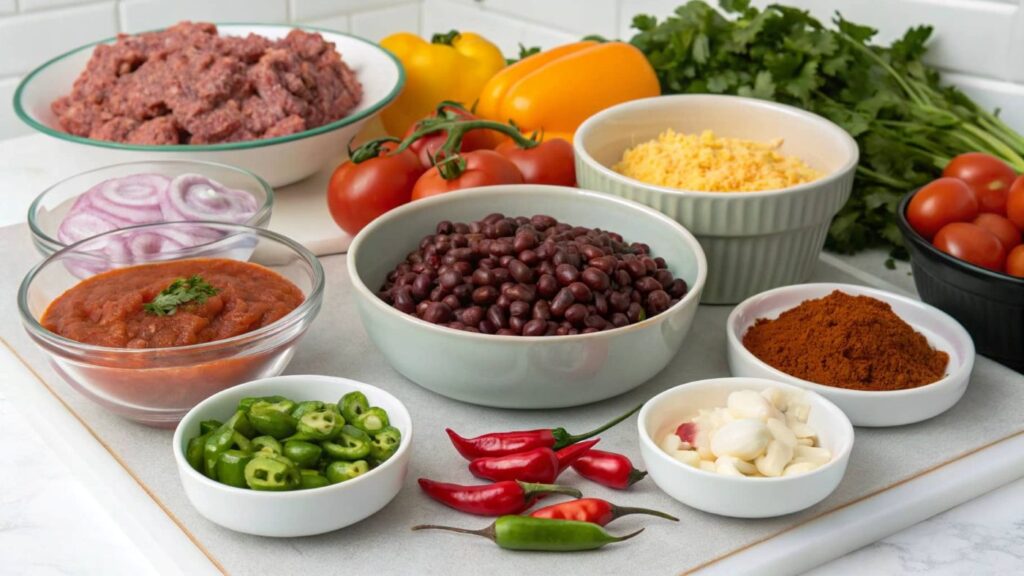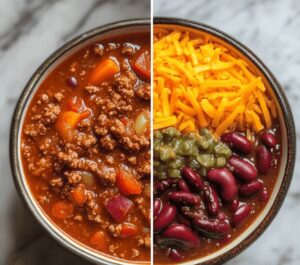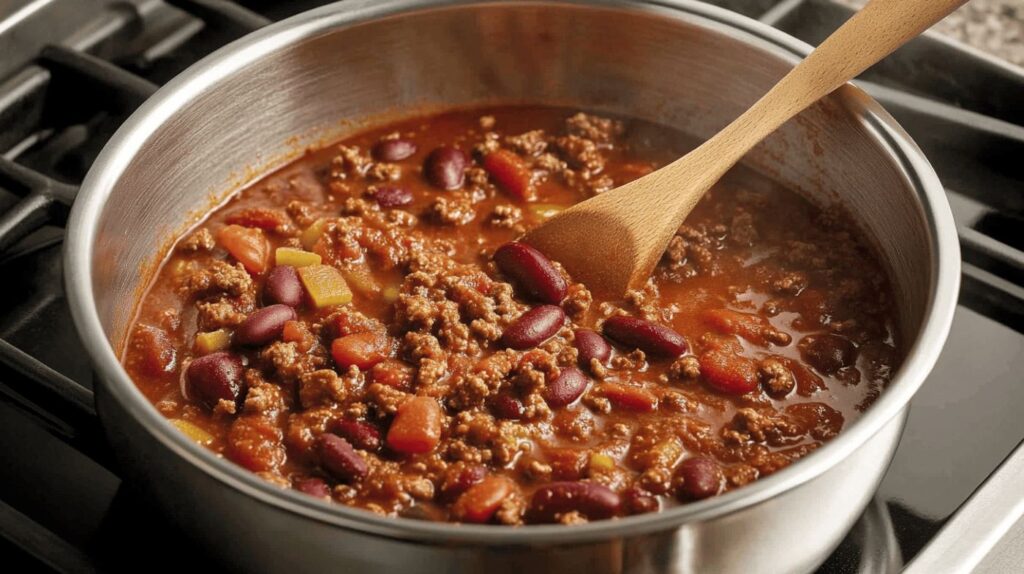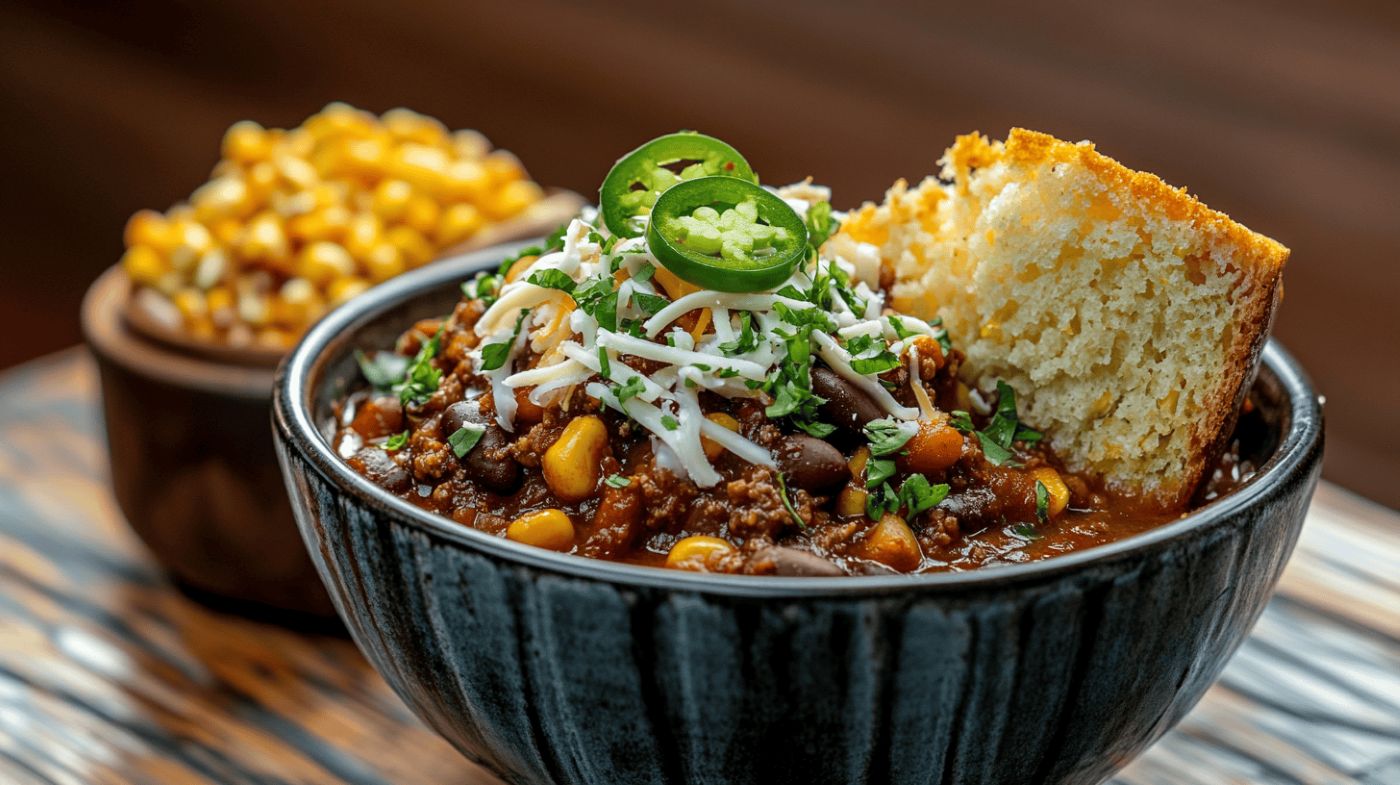Table of Contents
Introduction: What is Cowboy Chili Made Of?
Cowboy chili isn’t just a hearty meal; it’s a piece of history. This dish was born in the Wild West, where cowboys needed meals that were simple, filling, and full of flavor. With limited ingredients on the trail, they combined meat, beans, and spices to create something timeless.
Today, cowboy chili remains a favorite for its bold taste and ease of preparation. In this article, we’ll uncover what cowboy chili is made of. You’ll learn about its origins, essential ingredients, and simple ways to prepare it. We’ll also explore variations and the best ways to serve it. Whether you’re making it for a family dinner or a weekend gathering, this guide will help you bring the authentic taste of cowboy chili to your table.
Let’s dive into the details and make your next chili unforgettable!
The Origins of Cowboy Chili
Cowboy chili traces back to the 19th century. Cowboys on cattle drives needed meals that were quick to prepare but kept them energized. Chili fit the bill perfectly. They often carried dried meat, beans, and spices, making it easy to create a one-pot meal over an open fire.
Its origins also reflect the influence of Mexican cuisine, with chili peppers and spices playing a key role. Over time, it became a staple in the American Southwest, celebrated for its rich flavor and hearty ingredients. Today, it’s a comfort food enjoyed across the country.
Key Ingredients in Cowboy Chili

The magic of cowboy chili lies in its ingredients. Each one adds to the flavor and texture, creating a dish that’s both simple and satisfying.
Protein Choices
The heart of cowboy chili is the protein. Ground beef is the most common choice, but you can also use chicken, or even venison. These meats add richness and depth to the dish. For a more traditional feel, some recipes use chunks of beef rather than ground meat.
Beans or No Beans?

The beans debate is ongoing. In Texas, traditional chili often skips the beans, focusing solely on meat and spices. In other regions, beans like kidney or pinto beans are common. They add fiber and make the dish more filling. Your choice depends on your taste and how closely you want to stick to tradition.
Essential Spices and Seasonings
Spices are what set cowboy chili apart. Common seasonings include chili powder, cumin, garlic, and paprika. These spices bring warmth and complexity to the dish. You can adjust the spice level by adding cayenne or fresh chili peppers if you like it hotter. A pinch of sugar or a splash of vinegar can also balance the flavors.
How to Prepare Cowboy Chili
Making cowboy chili is straightforward. It’s all about layering flavors and letting the ingredients shine. Whether you’re cooking it on a stovetop or over a campfire, these steps ensure a flavorful result.
Prepping the Ingredients
Preparation is key to good chili. Start by gathering fresh ingredients. Chop onions, mince garlic, and dice any fresh peppers you plan to use. If you’re using canned beans or tomatoes, drain them first for better texture.
Heat a large pot or skillet over medium heat. Add a bit of oil to prevent sticking, and then sauté the onions and garlic until they’re soft and fragrant. This step builds the base of your chili.
Cooking Techniques

Once your onions and garlic are ready, add your meat of choice. Break it apart as it cooks, ensuring it browns evenly. Browning the meat creates rich flavors that define the dish.
After the meat is cooked, stir in your spices. Cooking the spices briefly before adding liquids helps release their flavors. Next, pour in canned tomatoes, tomato paste, or broth. These liquids bring everything together.
Let the chili simmer for at least 30 minutes, stirring occasionally. The longer it cooks, the better the flavors meld. Add the beans, if using, in the last 15 minutes so they stay firm.
Popular Variations of Cowboy Chili
Cowboy chili’s versatility has inspired countless variations, allowing cooks to put their own spin on the classic recipe. These adaptations highlight different flavors and ingredients while preserving the hearty essence of the dish.
White Cowboy Chili
White cowboy chili offers a lighter, creamier twist on the traditional recipe. Instead of beef and red beans, this version features white beans, shredded or diced chicken, and green chiles. The base often includes chicken broth and a touch of cream or sour cream for richness. The use of spices like cumin, oregano, and coriander enhances the Southwestern flair, while the green chiles add a mild, tangy heat. This variation is perfect for those seeking a milder yet equally satisfying chili experience.
Smoky Cowboy Chili
For a deeper, bolder flavor, smoky cowboy chili incorporates ingredients that add a distinct smokiness. Smoked paprika, chipotle peppers in adobo, or a dash of liquid smoke are popular choices. These elements pair well with the traditional beef and tomato base, creating a dish that feels both robust and comforting. Some cooks also include fire-roasted tomatoes or grilled vegetables to amplify the smoky profile. This variation is ideal for anyone who loves rich, layered flavors in their chili.
Sweet and Spicy Cowboy Chili
Sweet and spicy cowboy chili offers a delightful balance between heat and sweetness. Ingredients like honey, brown sugar, or even molasses are used to offset the bold spices and peppers in the dish. The sweetness complements the savory beef and beans, creating a complex flavor profile. Some recipes take it a step further by adding sweet vegetables like corn or even fruit, such as diced peaches or pineapple, for an unexpected twist. This variation is a crowd-pleaser that appeals to those who enjoy a harmonious blend of flavors.
Each of these variations demonstrates how cowboy chili can evolve while still staying true to its roots. Whether light and creamy, rich and smoky, or sweet and spicy, there’s a version to satisfy every palate.
Modern Twists on Cowboy Chili
Cowboy chili is flexible, making it easy to adapt to different tastes. You can add new ingredients or try alternative cooking methods to suit your needs.
Vegetarian Cowboy Chili
For a meatless option, replace the protein with hearty vegetables like sweet potatoes or zucchini. Add extra beans, lentils, or tofu for protein. Spices remain the same, ensuring you don’t lose the classic chili flavor.
Unique Add-Ins
Many cooks like to experiment with unexpected ingredients. Try adding a splash of coffee or a square of dark chocolate for a deeper flavor. Corn kernels or roasted bell peppers can add sweetness and color.
Slow Cooker or Instant Pot Variations
If you prefer hands-off cooking, cowboy chili works well in a slow cooker or Instant Pot. For the slow cooker, combine all the ingredients and let them cook on low for 6-8 hours. With an Instant Pot, you can sauté the onions and meat directly, then use the pressure-cook function for faster results.
Serving Suggestions for Cowboy Chili
Cowboy chili is delicious on its own, but the right sides and toppings can elevate the meal. Serving it with complementary dishes adds texture, flavor, and variety to your table.
Classic Pairings
Cornbread is a traditional side that pairs beautifully with chili. Its sweetness balances the spice and richness of the dish. You can serve it as muffins, slices, or crumbles on top of the chili.
Tortilla chips or crackers are great for dipping. They add crunch and make the meal more interactive. Some prefer serving chili over rice, which turns it into a heartier dish and helps mellow the spices.
Toppings to Enhance Flavor
The toppings you choose can completely change the experience of eating chili. Grated cheese, sour cream, and sliced jalapeños are popular choices. Fresh cilantro or chopped green onions add a burst of freshness.
For a little extra texture, consider adding crispy bacon bits or fried onions. Avocado slices or a drizzle of lime juice can introduce a creamy or tangy note.
Presentation Ideas
Serving cowboy chili in a rustic cast-iron pot or individual bowls gives it an authentic feel. If you’re hosting a gathering, consider setting up a chili bar with bowls of toppings so guests can customize their meals. This approach works well for casual get-togethers and ensures everyone gets their perfect bowl of chili.
Health Benefits of Cowboy Chili
Cowboy chili isn’t just tasty—it’s also packed with nutrients. Many of its ingredients provide essential vitamins, minerals, and other health benefits, making it a wholesome meal option.
High in Protein
The protein from meat, beans, or alternative sources supports muscle health and keeps you feeling full longer. For those looking to cut down on red meat, lean options like turkey or chicken still provide excellent protein levels.
Rich in Fiber
If you include beans, cowboy chili becomes a great source of dietary fiber. Fiber aids digestion, regulates blood sugar, and promotes heart health. It also contributes to the dish’s satisfying, hearty texture.
Packed with Antioxidants
Tomatoes, chili peppers, and spices are loaded with antioxidants, which help protect your body from damage caused by free radicals. These ingredients also boost your immune system and add vibrant color to the dish.
Customizable for Special Diets
Chili is easy to adapt for various dietary needs. Vegetarians can load up on beans and vegetables. Those following a keto diet can skip the beans and opt for extra meat and low-carb vegetables. The flexibility of cowboy chili ensures you can enjoy it regardless of your nutritional goals.
Frequently Asked Questions About Cowboy Chili
Cowboy chili is a beloved dish with a rich history and endless variations, but many people have questions about its unique features, ingredients, and preparation. Below are answers to some of the most common queries.
What is the difference between cowboy chili and regular chili?
The main difference lies in its simplicity and heartiness. Cowboy chili often uses fewer, more rustic ingredients, reflecting its origins as a practical meal for cowboys on cattle drives. While regular chili might include a variety of vegetables, beans, and even toppings like cheese or sour cream, cowboy chili focuses on the essentials: beef, beans (optional in some regions), tomatoes, and bold spices. It’s designed to be filling and easy to prepare with what’s available.
What is Texas Roadhouse chili made of?
Texas Roadhouse chili is a flavorful take on the classic dish, known for its bold and slightly spicy profile. It features ground beef as the primary protein, combined with tomato-based ingredients like diced tomatoes and sauce. Traditional chili spices such as chili powder, cumin, and paprika add heat and depth. Unlike some other variations, Texas Roadhouse chili typically excludes beans, staying true to the Texas-style preference for a meat-forward dish.
What’s the difference between regular chili and Texas chili?
Texas chili, often called “chili con carne,” differs from regular chili in its focus on meat and the absence of beans or other fillers. The ingredients center on chunks of beef or ground meat, a rich blend of chili peppers, and spices. This version emphasizes bold, smoky flavors and is thicker and heartier than regular chili. Regular chili, by contrast, often includes beans, vegetables, and sometimes sweeter or milder flavor profiles.
What is the history of cowboy chili?
Cowboy chili has its roots in the Old West during the 1800s, where it served as a practical and nutritious meal for cowboys on cattle drives. Ingredients had to be durable and easy to transport, leading to the use of dried beans, preserved meats, and dried chilies. The dish was cooked in a single pot over an open fire, making it both efficient and hearty. Over time, cowboy chili evolved into a symbol of Western cuisine, embodying the rugged simplicity and adaptability of its origins.
These answers shed light on the unique characteristics of cowboy chili and its many variations, helping to appreciate the history and appeal of this classic dish.
Explore More About Chili and Related Dishes
For additional inspiration, you can explore some related recipes and tips on Cooking Flare:
- Discover The Best Texas Chili Recipe: Simple, Smoky, and Delicious to compare the differences between Texas-style and cowboy chili.
- Learn What Not to Put in Meatloaf for expert cooking advice applicable to hearty dishes like chili and more.
- Uncover the Secret to Juicy Meatloaf and see how similar principles of flavor-building apply to cowboy chili.
Conclusion: Embrace the Cowboy Chili Tradition
Cowboy chili is more than just a meal—it’s a tradition. From its roots in the Wild West to its place on modern dinner tables, this dish represents comfort, simplicity, and bold flavors. With just a few basic ingredients and simple techniques, you can recreate a taste of history in your kitchen.
Whether you prefer it with or without beans, mild or spicy, cowboy chili is endlessly adaptable. Serve it with your favorite sides and toppings to make it your own. So, grab your ingredients, light the stove, and get ready to enjoy a hearty, delicious bowl of cowboy chili.
Enjoy the flavors and share the tradition with friends and family!

